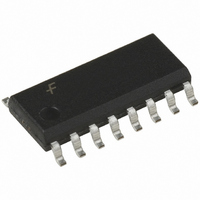ML4824CS1 Fairchild Semiconductor, ML4824CS1 Datasheet - Page 10

ML4824CS1
Manufacturer Part Number
ML4824CS1
Description
IC PFC PWM CTRLR COMBO 16-SOIC
Manufacturer
Fairchild Semiconductor
Datasheet
1.ML4824IP1.pdf
(15 pages)
Specifications of ML4824CS1
Mode
Average Current
Frequency - Switching
76kHz
Current - Startup
700µA
Voltage - Supply
10.5 V ~ 13.2 V
Operating Temperature
0°C ~ 70°C
Mounting Type
Surface Mount
Package / Case
16-SOIC (0.300", 7.5mm Width)
Switching Frequency
81 KHz
Maximum Operating Temperature
+ 150 C
Mounting Style
SMD/SMT
Minimum Operating Temperature
- 65 C
Lead Free Status / RoHS Status
Lead free / RoHS Compliant
ML4824
V
The V
and inhibits the PWM if this voltage on V
its nominal 2.5V. Once this voltage reaches 2.5V, which
corresponds to the PFC output capacitor being charged to its
rated boost voltage, the soft-start begins.
PWM Control (RAMP 2)
When the PWM section is used in current mode, RAMP 2 is
generally used as the sampling point for a voltage represent-
ing the current in the primary of the PWM’s output trans-
former, derived either by a current sensing resistor or a
current transformer. In voltage mode, it is the input for a
ramp voltage generated by a second set of timing compo-
nents (R
value of zero volts and should have a peak value of approxi-
mately 5V. In voltage mode operation, feedforward from the
PFC output buss is an excellent way to derive the timing
ramp for the PWM stage.
Soft Start
Start-up of the PWM is controlled by the selection of the
external capacitor at SS. A current source of 50µA supplies
the charging current for the capacitor, and start-up of the
PWM begins at 1.25V. Start-up delay can be programmed by
the following equation::
where C
is the desired start-up delay.
It is important that the time constant of the PWM soft-start
allow the PFC time to generate sufficient output power for
the PWM section. The PWM start-up delay should be at least
5ms.
Solving for the minimum value of C
Caution should be exercised when using this minimum soft
start capacitance value because premature charging of the SS
capacitor and activation of the PWM section can result if
V
start-up. The magnitude of V
line voltage and nominal PFC output voltage. Typically, a
1.0 F soft start capacitor will allow time for V
out to reach their nominal values prior to activation of the
PWM section at line voltages between 90Vrms and
265Vrms.
GENERATING V
The ML4824 is a current-fed part. It has an internal shunt
voltage regulator, which is designed to regulate the voltage
internal to the part at 13.5V. This allows a low power dissipa-
tion while at the same time delivering 10V of gate drive at
the PWM OUT and PFC OUT outputs. It is important to
10
IN
FB
C
C
OK Comparator
SS
SS
is in the hysteresis band of the V
IN
=
RAMP2
=
SS
OK comparator monitors the DC output of the PFC
5ms
t
DELAY
is the required soft start capacitance, and t
CC
, C
--------------- -
1.25V
50 A
RAMP2
--------------- -
1.25V
50 A
=
), which will have a minimum
200nF
FB
at start-up is related both to
SS
IN
:
OK comparator at
FB
is less than
FB
and PFC
DELAY
(6)
limit the current through the part to avoid overheating or
destroying it. This can be easily done with a single resistor in
series with the Vcc pin, returned to a bias supply of typically
18V to 20V. The resistor’s value must be chosen to meet the
operating current requirement of the ML4824 itself (19mA
max) plus the current required by the two gate driver outputs.
EXAMPLE:
With a V
ML4824 driving a total gate charge of 110nC at 100kHz
(e.g., 1 IRF840 MOSFET and 2 IRF830 MOSFETs), the
gate driver current required is:
To check the maximum dissipation in the ML4824, find the
current at the minimum V
The maximum allowable I
able design.
The ML4824 should be locally bypassed with a 10nF and a
1 F ceramic capacitor. In most applications, an electrolytic
capacitor of between 100 F and 330 F is also required
across the part, both for filtering and as part of the start-up
bootstrap circuitry.
Leading/Trailing Modulation
Conventional Pulse Width Modulation (PWM) techniques
employ trailing edge modulation in which the switch will
turn on right after the trailing edge of the system clock.
The error amplifier output voltage is then compared with the
modulating ramp. When the modulating ramp reaches the
level of the error amplifier output voltage, the switch will be
turned OFF. When the switch is ON, the inductor current will
ramp up. The effective duty cycle of the trailing edge modu-
lation is determined during the ON time of the switch. Figure
4 shows a typical trailing edge control scheme.
I
R
I
Figure 3. External Component Connections to V
GATEDRIVE
CC
BIAS
=
BIAS
=
20V 12.4V
-------------------------------- -
-------------------------------------- -
19mA
180
20V 14.6V
ML4824
of 20V, a V
V BIAS
–
V CC
GND
=
100kHz 100nC
–
R BIAS
+
11mA
=
CC
CC
42.2mA
CC
CERAMIC
=
(12.4V)::
limit of 14.6V (max) and the
10nF
is 55mA, so this is an accept-
180
PRODUCT SPECIFICATION
=
11mA
CERAMIC
REV. 1.0.6 11/7/03
1 F
CC
(7)
(8)
(9)











